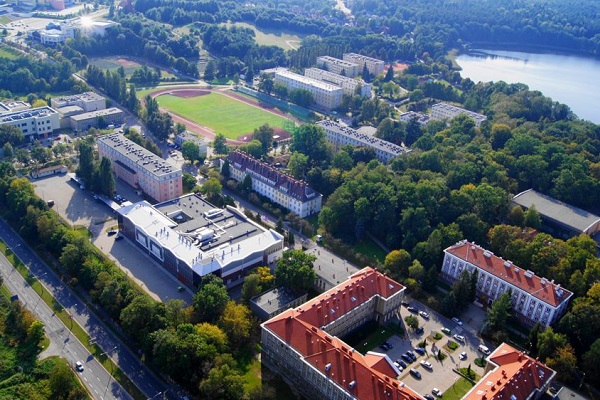
The Medical School of the University of Warmia and Mazury in Olsztyn consists of several departments dedicated to different disciplines and areas of medical education and research. Some of the main departments within the Medical School include:
-
Department of Anatomy: Studies the structure and organization of the human body, including gross anatomy, histology, and embryology.
-
Department of Physiology: Investigates the functions and mechanisms of the human body at the cellular, organ, and systemic levels.
-
Department of Biochemistry: Explores the chemical processes and substances within living organisms, emphasizing their relevance to human health and disease.
-
Department of Pharmacology: Deals with the study of drugs and their effects on the body, including mechanisms of action and therapeutic applications.
-
Department of Internal Medicine: Specializes in the diagnosis and treatment of various medical conditions affecting the internal organs, such as the heart, lungs, kidneys, and digestive system.
-
Department of Surgery: Focuses on surgical procedures and techniques, covering various specialties like general surgery, orthopedic surgery, neurosurgery, and more.
-
Department of Obstetrics and Gynecology: Dedicated to women's reproductive health, including prenatal care, childbirth, gynecological conditions, and reproductive system disorders.
-
Department of Pediatrics: Concentrates on the medical care of infants, children, and adolescents, addressing their unique healthcare needs and developmental stages.
-
Department of Radiology: Specializes in medical imaging techniques, including X-rays, ultrasound, computed tomography (CT), magnetic resonance imaging (MRI), and nuclear medicine scans.
-
Department of Medical Microbiology: Deals with the study of microorganisms, such as bacteria, viruses, and fungi, and their role in infectious diseases.
-
Department of Pathology: Focuses on the study and diagnosis of disease through the examination of tissues, organs, and bodily fluids.
-
Department of Forensic Medicine: Involved in the investigation of medicolegal cases, including determining causes of death and forensic examination of evidence.
-
Department of Public Health: Concerned with promoting and protecting the health of populations, addressing factors influencing community health and disease prevention.
-
Department of Medical Psychology: Explores the psychological aspects of health and illness, including the impact of psychological factors on physical well-being.
-
Department of Medical Education: Focuses on the development and implementation of medical education programs, curriculum design, and teaching methodologies.
-
Department of Medical Ethics and History of Medicine: Explores ethical principles in medical practice and research, as well as the historical development of medical knowledge and practices.
-
Department of Medical Informatics: Deals with the use of information technology and data management systems in healthcare delivery, research, and decision-making.
-
Department of Biophysics: Investigates the application of physical principles and techniques to biological systems, such as studying the properties of biological molecules.
-
Department of Medical Biotechnology: Focuses on the application of biotechnological tools and techniques in medical research, diagnostics, and therapeutics.
-
Department of Medical Genetics: Studies the genetic basis of diseases, including the diagnosis, prevention, and treatment of genetic disorders.
-
Department of Immunology: Explores the immune system and its role in health and disease, including immune responses, immunodeficiencies, and immunotherapy.
-
Department of Oncology: Specializes in the diagnosis and treatment of cancer, including various modalities such as chemotherapy, radiation therapy, and targeted therapies.
-
Department of Neurology: Focuses on the diagnosis and management of neurological disorders affecting the brain, spinal cord, and nerves.
-
Department of Neurosurgery: Deals with surgical interventions for neurological conditions, including brain and spinal cord surgeries.
-
Department of Ophthalmology: Specializes in the diagnosis and treatment of eye diseases and visual impairments.
-
Department of Otolaryngology (Ear, Nose, and Throat): Concentrates on disorders of the ear, nose, throat, and related structures, including hearing and balance problems.
-
Department of Dermatology: Specializes in the diagnosis and treatment of skin disorders, including dermatological conditions, allergies, and skin cancers.
-
Department of Psychiatry: Focuses on the diagnosis, treatment, and management of mental health conditions, including psychiatric disorders and psychological well-being.
-
Department of Rehabilitation Medicine: Deals with the restoration and improvement of physical functioning and quality of life in individuals with disabilities or impairments.
-
Department of Emergency Medicine: Specializes in the management of acute medical conditions and emergencies, providing immediate care and stabilization.
-
Department of Family Medicine: Focuses on comprehensive and continuous healthcare for individuals and families, emphasizing preventive care and primary healthcare services.
-
Department of Dental Surgery: Specializes in oral and maxillofacial surgical procedures, including extractions, dental implants, and corrective jaw surgeries.
-
Department of Oral Pathology: Focuses on the study and diagnosis of diseases affecting the oral and maxillofacial regions, including oral cancers and oral mucosal disorders.
-
Department of Periodontology: Concentrates on the prevention, diagnosis, and treatment of gum diseases and conditions affecting the supporting structures of the teeth.
-
Department of Prosthodontics: Specializes in the restoration and replacement of missing teeth and oral structures through prosthetic devices like dentures, bridges, and implants.
-
Department of Orthodontics: Focuses on the diagnosis and treatment of dental and skeletal irregularities, including the alignment of teeth and jaws.
-
Department of Dental Radiology: Deals with the use of imaging techniques to diagnose and assess dental and oral conditions, including X-rays and cone-beam computed tomography (CBCT).
-
Department of Dental Materials Science: Investigates the properties, selection, and application of materials used in dentistry, including dental restorations and prosthetics.
-
Department of Medical Education and Simulation: Develops and implements simulation-based medical training programs to enhance practical skills and clinical decision-making.




